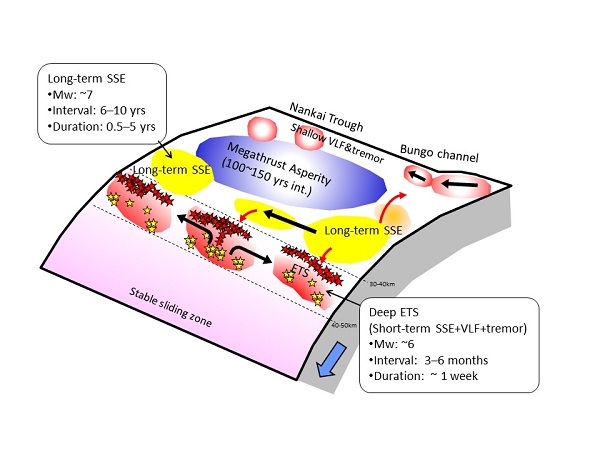Connecting slow earthquakes to huge earthquakes What we can learn from ongoing research on slow earthquakes


Schematic view of the heterogeneous distribution of various types of slow earthquakes in the Nankai subduction zone
Black arrows indicate the direction of the spread of slow earthquakes, and red arrows show interactions between long-term slow slip events (SSEs) and other slow earthquakes. Red and yellow stars indicate tremors at the upper ends and lower parts, respectively, of the dipping plate interface where episodic tremors and slip (ETS) events occur. Upper ends of deep ETS zones are easily influenced by long-term SSEs, and long-term SSEs also trigger the behavior of slow earthquakes along the Nankai Trough, near the southwestern coast of Japan.
© 2016 Kazushige Obara.
A research team at the University of Tokyo has assessed the connection between slow earthquakes and huge megathrust earthquakes that occur at plate boundaries shared by the two types of quakes. The team has evaluated three functions that slow earthquakes may serve in relation to giant quakes by reviewing aggregate studies in the nascent research area of slow earthquakes. Careful and precise monitoring of slow earthquakes, characterized by the slow slip behavior of geological faults compared to traditional quakes, holds promise of providing a new perspective in predicting the occurrence of huge earthquakes.
Slow earthquakes are seismic phenomena in which the rupture of geological faults in the earth's crust occurs gradually without creating strong tremors. However, many slow earthquakes have been observed on the subduction plate interface--the boundary where two tectonic plates converge thrusting one plate under the other—near the seismogenic zone where huge earthquakes are generated. Because the fault slip mechanism of slow earthquakes is the same as that of huge quakes, slow earthquakes have been thought to be connected to huge megathrust earthquakes.
The research team of Professor Kazushige Obara and Associate Professor Aitaro Kato at the Earthquake Research Institute of the University of Tokyo reviewed comprehensive research data on slow earthquakes occurring in nearly the previous two decades, and presented three possible roles they can play in connection to huge earthquakes.
The first is as useful analogs of megathrust earthquakes, as slow earthquakes occur frequently and their behavior is similar to that of huge quakes; the second is as stress meters because of their high sensitivity to stress changes in the megathrust seismogenic zone, which may be observed through changes in slow-earthquake behavior; and the third is as agents of stress transfer whereby force from the slow quakes is loaded on to adjacent megathrust source faults, thereby increasing the probability of rupturing the fault areas.
The researchers hope to contribute to the understanding of the events leading to huge earthquakes with their general introduction outlining the research on slow earthquakes so far, and through continued monitoring of the quakes’ behavior.
”When I made the first-ever discovery of a deep low-frequency tremor, which is a type of slow earthquake, in 2002, I felt a vague sense of unease that it foreshadowed a huge earthquake,” says Obara. He continues, “However, with the progress in slow-earthquake research, we have come to observe certain relationships between slow earthquakes and huge earthquakes, and I believe our findings will help guide the future direction of slow-earthquake research.”
Paper
, "Connecting slow earthquakes to huge earthquakes", Science Online Edition: 2016/07/15 (Japan time), doi: 10.1126/science.aaf1512.
Article link (Publication, UTokyo Repository)






